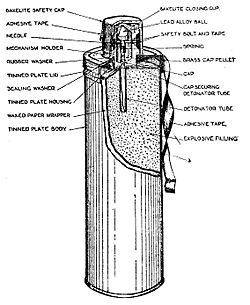No. 73 grenade facts for kids
Quick facts for kids No. 73 |
|
|---|---|

Hand percussion grenade (anti-tank No. 73 Mark I)
|
|
| Type | Anti-tank grenade |
| Place of origin | United Kingdom |
| Service history | |
| In service | 1940–1941 1943–?1945 |
| Used by | United Kingdom |
| Wars | Second World War |
| Specifications | |
| Mass | 4.5 pounds (2.0 kg) |
| Length | 11 inches (280 mm) |
| Diameter | 3.5 inches (89 mm) |
|
|
|
| Filling | Polar ammonal gelatine dynamite or nitrogelatine |
| Filling weight | 3.5 pounds (1.6 kg) |
|
Detonation
mechanism |
Impact |
The No. 73 grenade was a special type of grenade used by the British during the Second World War. It was designed to stop enemy tanks. People also called it the "Thermos" bomb because it looked a bit like a Thermos flask. Other nicknames were "Woolworth bomb" or "hand percussion grenade."
Contents
Why New Weapons Were Needed
After the Battle of France in 1940, many British soldiers had to leave France quickly from Dunkirk. They left behind a lot of their heavy weapons, like anti-tank guns. This meant that Britain didn't have enough weapons to defend itself if Germany decided to invade.
The British Army only had a few anti-tank guns left. They also didn't have much ammunition for them. Because of this, new and simpler anti-tank weapons were urgently needed. These new weapons had to be easy and cheap to make quickly. Many of them were hand grenades. Other special grenades included the "sticky bomb" (which stuck to tanks) and the No. 76 grenade (which used white phosphorus to start fires). The No. 73 grenade was one of the simplest designs.
What It Looked Like and How It Worked
The No. 73 grenade was shaped like a cylinder. It had a plastic cap that screwed on, which made it look like a Thermos flask. This is how it got its famous nickname.
The grenade was about 3.5 inches (89 mm) wide and 11 inches (280 mm) long. It weighed about 4.5 pounds (2.0 kg). Inside, it had 3.5 pounds (1.6 kg) of a powerful explosive. This explosive was very flammable and could even explode if hit by small bullets.
To use it, a soldier would throw the grenade at a tank. As it flew, a weighted tape held by the soldier would unroll. This tape would pull out a safety pin. Pulling the pin armed the grenade, and it would explode when it hit something. Because it was so heavy, it could only be thrown a short distance, about 10 to 15 yards (9 to 14 meters). Soldiers had to find cover quickly after throwing it to avoid getting hurt by the explosion.
The No. 73 grenade could break through about 2 inches (51 mm) of tank armor. It was especially good at damaging the tracks of light tanks. If a tank's tracks were blown off, the tank would have to stop for repairs.
Its Story in the War
The No. 73 grenade was first given to soldiers in late 1940. However, it wasn't often used to fight tanks directly. Instead, soldiers often removed its special fuse and used it as a small demolition charge to blow things up.
The grenade was taken out of service within a year. But it was brought back in 1943. This time, it was specifically used for demolition work. A shorter version of the grenade was even used in a famous event. On May 27, 1942, a soldier named Jan Kubiš used a modified No. 73 grenade in Prague. He threw it at a car carrying a high-ranking German officer, Reinhard Heydrich.
See also

